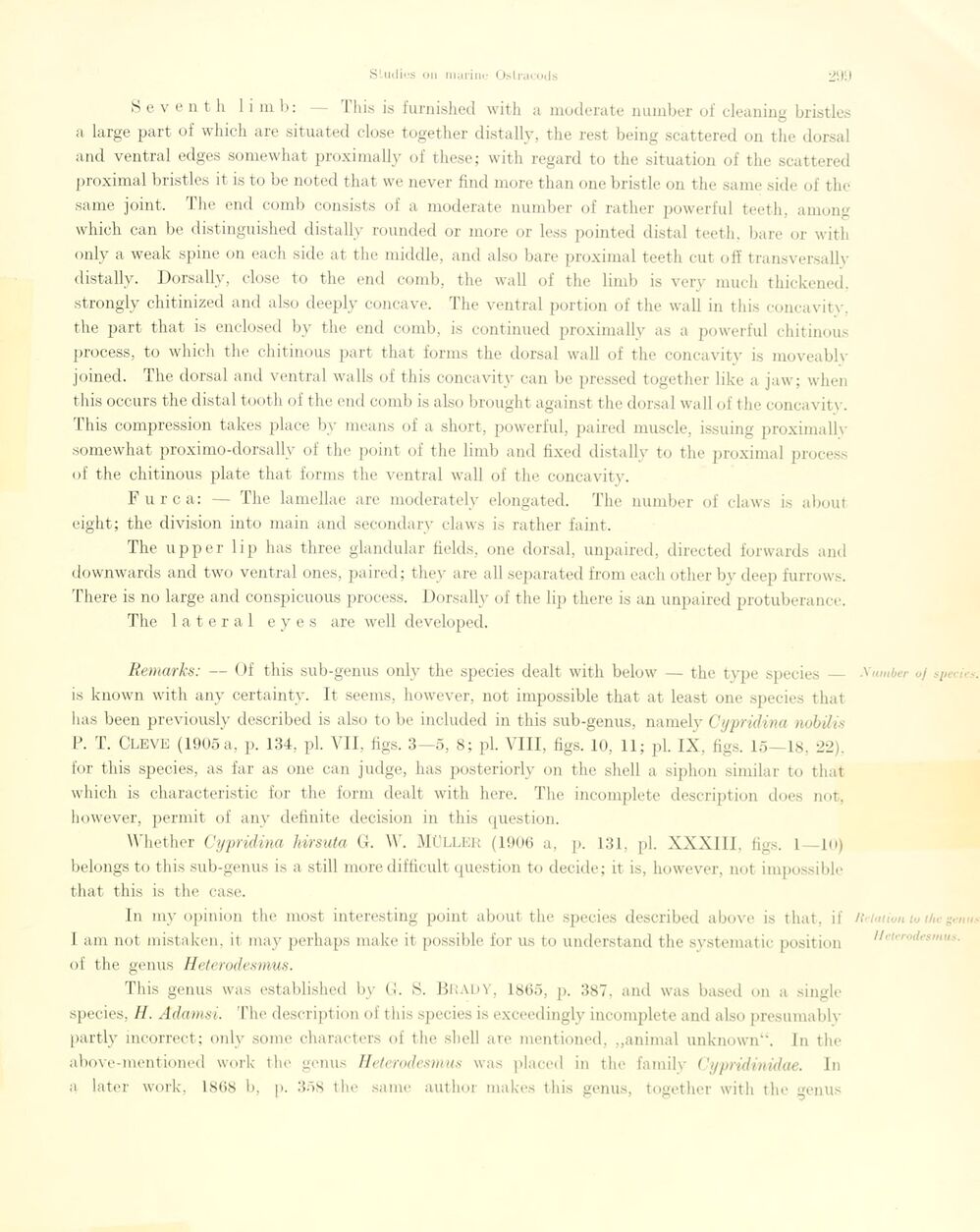
Full resolution (JPEG) - On this page / på denna sida - Sidor ...

<< prev. page << föreg. sida << >> nästa sida >> next page >>
Below is the raw OCR text
from the above scanned image.
Do you see an error? Proofread the page now!
Här nedan syns maskintolkade texten från faksimilbilden ovan.
Ser du något fel? Korrekturläs sidan nu!
This page has never been proofread. / Denna sida har aldrig korrekturlästs.
Se venth 1 i mb: — This is furnished with a moderate number of eleaning bristles
a large part of which are situated close together distally, tlie rest being scattered on the dorsal
and ventral edges somewhat proximally of tliese; with regard to the situation of the scattered
proximal bristles it is to be noted that we never find more than one bristle on the same side of the
same joint. The end comb consists of a moderate number of rather powerful teeth, among
which can be distinguished distally rounded or more or less pointed distal teeth. bare or with
only a weak spine on each side at the middle, and also bare proximal teeth cut off transversallv
distally. Dorsally, close to the end comb, the wall of the limb is very mucli thickened,
strongly chitinized and also deeply concave. The ventral portion of the wall in this concavitv,
the part that is enclosed by the end comb, is continued proximally as a powerful ehitinous
process, to which the ehitinous part tlnit forms the dorsal wall of the concavitv is moveablv
joined. The dorsal and ventral walls of this concavitv can be pressed together like a jaw; when
this occurs the distal tooth of the end comb is also brought against the dorsal wall of the concavitv.
This compression takes place by means of a short, powerful, paired muscle, issuing proximally
somewhat proximo-dorsally of the point of the limb and fixed distally to the proximal process
of the ehitinous plate that forms the ventral wall of the concavity.
Furca: — The lamellae are moderately elongated. The number of claws is about
eight; the division into main and secondary claws is rather faint.
The upper lip has three glandular fields, one dorsal, unpaired, directed forwards and
downwards and two ventral ones, paired ; they are all separated from each other by deep furrows.
There is no large and conspicimus process. Dorsally of the lip there is an unpaired protubérance.
The lateral eyes are well developed.
Remarks: — Of this sub-genus only the species dealt with below — the type species
is known with any certainty. It seems, however, not impossible that at least one species that
has been previously described is also to be included in this sub-genus, namely Cypridina nobilis
P. T. CLEVE (1905a, p. 134, pi. Vil, figs. 3—5, 8; pi. VIII, figs. 10, 11; pi. IX, figs. 15—18, 22).
for this species, as far as one can judge, has posteriorly on the shell a siphon similar to that
which is characteristic for the form dealt with here. The incomplete description does not,
however, permit of any definite decision in this question.
Whether Cypridina hirsuta G. \\. Müller (1906 a, p. 131, pl. XXXIII. figs. 1—lo)
belongs to this sub-genus is a still more difficult question to decide; it is, however, not impossible
that this is the case.
In my opinion the most interesting point about the species described above is that, if
I am not mistaken, it may perhaps make it possible for us to understand the systematic position
of the genus Heterodesmus.
This genus was established by G. S. BladY, 1865, p. 387, and was based on a single
species, H. Adamsi. The description of this species is exceedingly incomplete and also presumably
partly incorrect; only some characters of the shell are mentioned, „animal unknown". In the
above-mentioned work the genus Heterodesmus was placed in the fa mily Cypridinidae. In
a later work, 1868 b, p. 358 the same author makes this genus, together with the genus
Xumber oj species
lie/ation to the gen tt
Meterodes tnus.
<< prev. page << föreg. sida << >> nästa sida >> next page >>